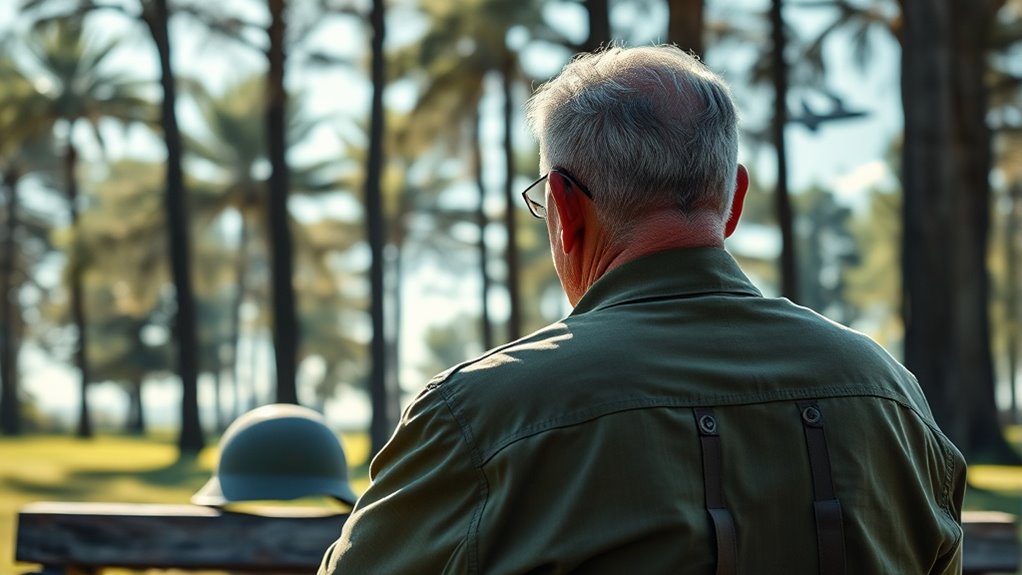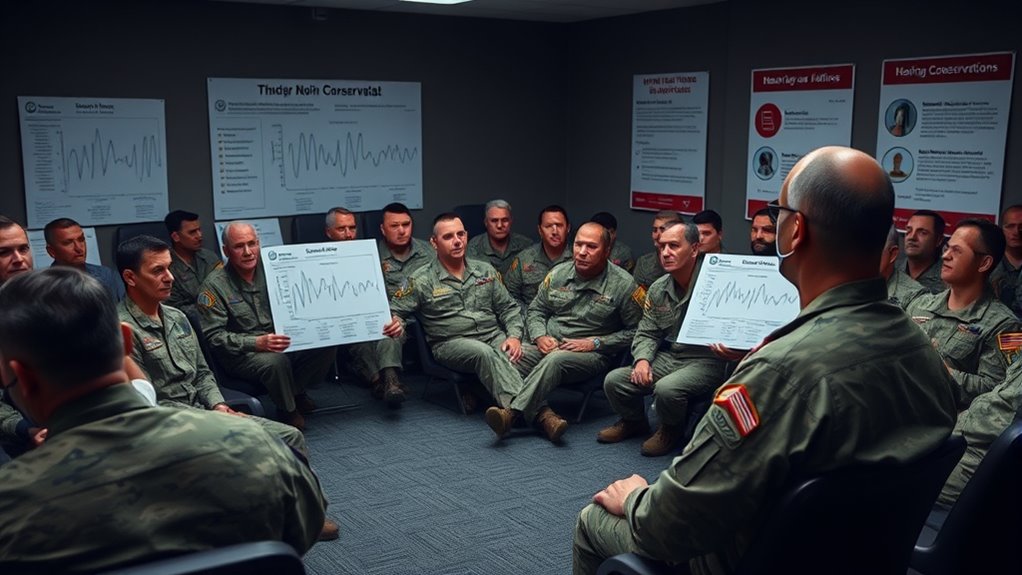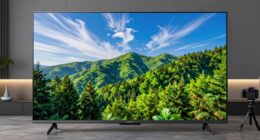Research shows that military noise exposure can cause lasting hearing loss in veterans, even with recovery efforts. Prolonged or repetitive loud noise increases the risk, while protective gear helps but doesn’t eliminate damage. Advances in technology and stricter policies aim to reduce these effects. By managing exposure and using proper protection, veterans can minimize long-term damage. If you want to understand how these factors impact veterans’ hearing health over time, there’s more to explore.
Key Takeaways
- Extensive research confirms a strong link between military noise exposure and long-term hearing impairment in veterans.
- Cumulative noise exposure, even brief high-level bursts, significantly increases the risk of chronic hearing loss.
- Protective strategies like earplugs and sound barriers effectively reduce, but do not eliminate, hearing damage risk over time.
- Advances in diagnostic technology enable early detection and monitoring of hearing damage in military personnel.
- Ongoing studies focus on personalized treatments and better noise management policies to mitigate long-term auditory health issues.
Understanding Noise-Induced Hearing Loss in Service Members

Noise-induced hearing loss (NIHL) is a common injury among service members exposed to loud environments during military operations. You might notice difficulty hearing high-pitched sounds or understanding speech, especially in noisy settings. Over time, NIHL can impair auditory processing, making it harder to interpret sounds accurately. Many veterans with NIHL turn to hearing aids to improve their hearing clarity. These devices amplify sounds and help you distinguish speech from background noise, improving communication. However, hearing aids don’t fully restore normal auditory processing, especially if the damage is severe. Understanding the impact of loud noise exposure helps you recognize early signs of hearing loss and seek timely intervention, preventing further deterioration and enhancing your quality of life during and after service.
Key Findings From Recent Veteran Hearing Studies

Recent studies show a clear link between military noise exposure and hearing loss in veterans. They also reveal that longer exposure durations increase the risk of more severe hearing damage. Understanding these findings helps you see why early intervention and prevention are essential.
Hearing Loss Correlation
Studies have consistently shown a strong link between military noise exposure and hearing loss among veterans. Recent research indicates that even with auditory recovery efforts, hearing damage often persists, highlighting the importance of early noise mitigation. Veterans exposed to loud environments frequently experience measurable declines in hearing acuity, regardless of initial recovery. These studies reveal that cumulative noise exposure directly correlates with the severity of hearing loss later in life. Effective noise mitigation strategies, like protective gear and sound barriers, can reduce the extent of damage, but they don’t eliminate it entirely. Recognizing this correlation emphasizes the need for proactive measures during service and ongoing audiological support post-discharge to protect veterans’ hearing health long-term. Additionally, understanding the impact of sound technology on noise levels can inform better protective strategies and equipment design to safeguard hearing in high-noise environments. Research also suggests that early intervention and continuous monitoring are crucial for minimizing long-term auditory health issues among veterans exposed to hazardous noise levels. Furthermore, ongoing studies highlight the importance of preventive measures in preserving hearing health, emphasizing that early action can significantly decrease the risk of permanent hearing loss. Research into long-term auditory health underscores the importance of continuous monitoring and intervention for veterans exposed to hazardous noise levels.
Exposure Duration Effects
The duration of noise exposure considerably influences the extent of hearing damage among veterans. Longer exposure increases the risk of auditory fatigue, where your ears become temporarily less sensitive due to repeated or sustained noise. This fatigue can mask early signs of damage, delaying awareness of hearing loss. Over time, your ears attempt noise adaptation, adjusting to persistent sounds, but this can also reduce your ability to detect important auditory cues. Studies show that even brief, repeated exposures can cumulatively cause significant hearing impairment. If you’re exposed to loud noises for extended periods, your risk of long-term hearing loss rises sharply. Recognizing the effects of exposure duration helps you take proactive steps to protect your hearing, such as using hearing protection during prolonged noise events. Understanding noise-induced hearing loss is crucial for developing effective prevention strategies. Additionally, ongoing research highlights the importance of early intervention to minimize permanent damage and improve long-term auditory health.
Risk Factors Contributing to Long-Term Hearing Damage

Your risk of long-term hearing damage increases with longer exposure to loud noises during service. Wearing protective gear can considerably reduce this risk, but many veterans don’t always use it consistently. Understanding these factors helps you take steps to protect your hearing for the future. Additionally, adopting preventive measures can further safeguard your hearing health over time. Proper filter replacement indicators and regular maintenance can ensure hearing protection devices function optimally, reducing damage risk. Recent advancements in AI technology are being explored to develop innovative hearing protection solutions that adapt to different noise environments and provide real-time feedback. Incorporating educational programs about noise hazards can empower veterans to make informed decisions about hearing protection. Proper risk assessment can also help identify high-exposure situations and develop targeted strategies to minimize hearing loss.
Duration of Exposure
Long-term hearing damage often results from prolonged exposure to loud noises, where the risk increases with each additional hour spent in noisy environments. The longer your exposure time, the greater your chances of sustaining irreversible hearing loss. Noise duration directly impacts the damage; even short periods can be harmful if loud enough. Understanding how exposure accumulates helps you recognize the importance of managing your time around noise. Here’s a breakdown:
| Exposure Time | Noise Duration | Risk Level |
|---|---|---|
| Less than 1 hr | Short | Low |
| 1-3 hrs | Moderate | Moderate |
| 3-6 hrs | Long | High |
| Over 6 hrs | Extended | Very High |
Reducing exposure time is essential to prevent long-term damage. Knowing your noise exposure can help you better protect your hearing health over time. Additionally, being aware of noise exposure limits can assist in establishing safer routines to minimize risk. Implementing protective measures such as earplugs or noise-canceling headphones further helps in safeguarding your hearing. Incorporating sound level awareness into your daily routine can further reduce the likelihood of damage. Moreover, understanding the effects of noise pollution emphasizes the importance of creating quieter environments whenever possible.
Use of Protective Gear
Wearing protective gear considerably reduces the risk of hearing damage from loud noises, especially during prolonged exposure. Ear protection, such as earplugs or earmuffs, is essential for effective noise mitigation. When you use proper ear protection, you block or dampen the intensity of harmful sounds, preventing long-term damage. It’s vital to wear your gear correctly and consistently in noisy environments like training or combat zones. Without adequate protection, your ears are vulnerable to the cumulative effects of loud noise, which can lead to permanent hearing loss. By making use of reliable ear protection, you actively reduce your risk of long-term hearing problems. Regular use of protective gear can also help maintain overall ear health and prevent issues related to noise exposure. Proper noise mitigation strategies, including the consistent use of hearing protection, are crucial for safeguarding your hearing health during military service. Additionally, understanding noise exposure guidelines can help you better manage and minimize risks during operations. Employing hearing conservation practices is essential in fostering long-term auditory health in environments with high noise levels.
Technological Advances in Hearing Protection and Diagnostics

Advancements in hearing protection and diagnostic technologies are transforming how military personnel guard against noise-induced hearing loss. Modern auditory diagnostics allow for earlier detection of hearing damage, enabling timely interventions. Portable diagnostic tools now provide rapid, accurate assessments in the field, reducing the risk of unnoticed deterioration. Protective technology has also advanced, with smarter hearing protection devices that adapt to noise levels, offering enhanced sound quality while blocking harmful noise. Noise-canceling headsets and earplugs now integrate active technology, improving comfort and effectiveness. These innovations help identify vulnerabilities sooner and prevent long-term impairments. Additionally, automation in business drives the development of sophisticated diagnostic devices, making assessments more efficient and accessible. The integration of smart technology into hearing devices enhances their responsiveness and user adaptability. By combining cutting-edge auditory diagnostics with innovative protective technology, military personnel can better safeguard their hearing health during service and beyond, ultimately reducing the incidence of noise-induced hearing loss among service members. Furthermore, ongoing research into biomedical sensors promises even more precise monitoring of auditory health in real-time.
Policy Changes and Preventive Measures in Military Settings

Recent technological improvements in hearing protection and diagnostics have prompted militaries worldwide to revisit and strengthen their policies on noise management. You are now part of efforts to enforce strict policy compliance, ensuring that protective equipment is worn consistently and correctly. Military organizations have implemented enhanced policy enforcement measures, including regular training and clear accountability protocols. Compliance monitoring has become more rigorous, with supervisors conducting routine checks and using technology to track protective gear usage. Additionally, compliance tracking systems have been introduced to provide real-time data on gear adherence, further minimizing risks. These steps aim to reduce noise-induced hearing loss among service members. By prioritizing policy adherence and continuous oversight, armed forces are actively reducing risks associated with noise exposure. Incorporating advanced monitoring technology into routine procedures further enhances compliance and effectiveness. This proactive approach promotes a culture of safety and helps preserve hearing health across all military operations.
Future Directions for Research and Veteran Support

Looking ahead, research must focus on developing more precise diagnostic tools and personalized treatment approaches for veterans suffering from noise-induced hearing loss. Enhancing psychological resilience can help veterans better cope with their condition, fostering mental well-being. To strengthen veteran support, efforts should include:
- Expanding community outreach programs that provide education and resources.
- Developing targeted therapies that address individual hearing loss patterns.
- Promoting peer support networks to build resilience and reduce isolation.
Frequently Asked Questions
How Does Military Noise Exposure Compare to Civilian Noise Risks?
You might think civilian noise risks are similar to military ones, but military noise levels are often much higher. You need to use proper hearing protection during loud activities, as exposure to intense noise can damage your hearing over time. While civilians encounter loud sounds too, the frequency and intensity in military settings pose greater risks, making hearing protection essential in both environments to prevent long-term hearing loss.
Are There Specific Military Roles More Susceptible to Hearing Loss?
Like Icarus flying too close to the sun, you’re more vulnerable in certain military roles. Combat roles and aviation personnel face higher noise levels, making them more susceptible to hearing loss. Your exposure to loud weapons, engines, and aircraft noise puts you at greater risk. Protecting your hearing is essential, especially if you’re in these high-risk positions, to avoid long-term damage and preserve your ability to hear life’s important moments.
What Are the Latest Treatments Available for Service-Related Hearing Impairment?
If you’re dealing with service-related hearing loss, current treatments include hearing aids and cochlear implants. Hearing aids amplify sounds, helping you hear more clearly in everyday situations. Cochlear implants are used for more severe loss, directly stimulating the auditory nerve for improved hearing. Both options can markedly enhance your quality of life, so consult your healthcare provider to determine the best solution for your specific needs.
How Do Military Hearing Protection Policies Differ Internationally?
Like a shield guarding your ears, military hearing protection policies symbolize safety. International standards differ, with some nations enforcing strict regulations and others adopting more extensive approaches. Policy variations reflect diverse military practices and resources. You’ll find that countries with thorough standards prioritize advanced hearing protection gear and training, while others may have gaps. Understanding these differences helps you appreciate global efforts to safeguard your hearing during service.
Can Early Intervention Prevent Long-Term Hearing Damage in Veterans?
You can prevent long-term hearing damage by prioritizing hearing conservation and implementing preventive measures early on. Wearing proper hearing protection, avoiding loud environments when possible, and seeking prompt audiological assessments help you reduce risk. Early intervention, such as ear screenings and education on noise hazards, is vital. Taking these steps now can safeguard your hearing health and minimize the potential for lasting damage in the future.
Conclusion
As you consider the long-term effects of military noise exposure, remember that each step forward in research and technology acts as a shield for veterans’ hearing health. While progress offers hope, it’s up to you—whether as a service member, supporter, or policymaker—to amplify prevention and awareness. Like a lighthouse guiding ships through darkness, your actions can illuminate a safer, healthier future, ensuring the sacrifices of service aren’t overshadowed by preventable loss.











